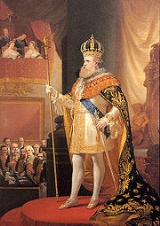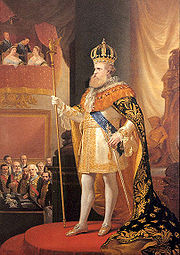
Imperial Crown of Brazil
Encyclopedia

Crown (headgear)
A crown is the traditional symbolic form of headgear worn by a monarch or by a deity, for whom the crown traditionally represents power, legitimacy, immortality, righteousness, victory, triumph, resurrection, honour and glory of life after death. In art, the crown may be shown being offered to...
manufactured for the second Brazilian Emperor, Pedro II
Pedro II of Brazil
Dom Pedro II , nicknamed "the Magnanimous", was the second and last ruler of the Empire of Brazil, reigning for over 58 years. Born in Rio de Janeiro, he was the seventh child of Emperor Dom Pedro I of Brazil and Empress Dona Maria Leopoldina and thus a member of the Brazilian branch of...
.
With the addition of this Crown to the Brazilian Imperial Regalia
Brazilian Imperial Regalia
The Imperial Regalia of Brazil consists of the Imperial Crowns: the Crown of Pedro II and the Crown of Pedro I; the Imperial Sceptre; the Imperial Orb; the Imperial Sword; and jewelry belonging to the Emperors and Empresses of Brazil....
, use of the previous, simpler Crown of Pedro I was abandoned. The design of the Crown of Dom Pedro II also replaced the design of the older diadem in flag
Flag of Brazil
The national flag of Brazil is a blue disc depicting a starry sky spanned by a curved band inscribed with the national motto, within a yellow rhombus, on a green field. Brazil officially adopted this design for its national flag on November 19, 1889, replacing the flag of the second Empire of Brazil...
and coat of arms
Coat of arms of Brazil
The coat of arms of Brazil was created on November 19, 1889, four days after Brazil became a republic.The coat of arms consists of the central emblem surrounded by coffee and tobacco branches, which were important crops in Brazil at that time.In the blue circle in the center, the Southern Cross ...
of the Brazilian Empire
Brazilian Empire
The Empire of Brazil was a 19th-century state that broadly comprised the territories which form modern Brazil. Its government was a representative parliamentary constitutional monarchy under the rule of Emperors Dom Pedro I and his son Dom Pedro II, both members of the House of Braganza—a...
, thus making the new Crown the official imperial Crown of the State.
The Crown of Dom Pedro I was simpler, having been quickly manufactured in 1822 for the Coronation
Coronation
A coronation is a ceremony marking the formal investiture of a monarch and/or their consort with regal power, usually involving the placement of a crown upon their head and the presentation of other items of regalia...
of Brazil's first Emperor, just a few months after the declaration of the country's independence.
When Brazil's second Emperor, Pedro II, was declared of age and preparations for his coronation began, the government saw the need to commission the manufacturing of a new crown.
Manufacture
The Crown of Dom Pedro II was created by the goldsmith Carlos Martin in Rio de JaneiroRio de Janeiro
Rio de Janeiro , commonly referred to simply as Rio, is the capital city of the State of Rio de Janeiro, the second largest city of Brazil, and the third largest metropolitan area and agglomeration in South America, boasting approximately 6.3 million people within the city proper, making it the 6th...
, and was first exhibited to the public on July 8, 1841, just days before the new monarch's Coronation that took place on July 18 of the same year.
The Crown's frame is made of quality 18 karat gold
Gold
Gold is a chemical element with the symbol Au and an atomic number of 79. Gold is a dense, soft, shiny, malleable and ductile metal. Pure gold has a bright yellow color and luster traditionally considered attractive, which it maintains without oxidizing in air or water. Chemically, gold is a...
. Its circlet
Circlet
A circlet is a crown with neither arches nor a cap ....
base supports eight imperial semi-arches, connected at the top by a golden monde
Monde (crown)
A monde is a ball-like object located near the top of a crown. It is the point at which a crown's half arches meet. It is usually topped off either with a national or religious symbol, for example a cross in Christian countries....
, which in turn is surmounted by a jeweled cross
Cross (crown)
A cross is the decoration located at the highest level of a crown on top of the monde. Its usage traditionally symbolised the Christian nature of the monarchy of that country, though not all crowns even in monarchies associated with Christianity used a cross as its top decoration, with some French...
, forming a globus cruciger
Globus cruciger
The globus cruciger is an orb topped with a cross , a Christian symbol of authority used throughout the Middle Ages and even today on coins, iconography and royal regalia...
. Inside the half-arches
Half-arch (crown)
A half-arch is the piece of gold, silver or platinum, usually decorated with jewels, that links the circlet of a hoop crown to the globe at the top of the crown.-British tradition of 4 half-arches:...
lies a dark-green velvet cap
Cap (crown)
The cap of a crown is the cap which fills the inner space of a modern crown. While ancient crowns contained no cap, from mediæval times it became traditional to fill the circlet with a cap of velvet or other such cloth, with a base of ermine....
. The Crown is set with 596 precious stones (mostly diamond
Diamond
In mineralogy, diamond is an allotrope of carbon, where the carbon atoms are arranged in a variation of the face-centered cubic crystal structure called a diamond lattice. Diamond is less stable than graphite, but the conversion rate from diamond to graphite is negligible at ambient conditions...
s), totalling 91184 carats (18.2 kg), and 80 pearl
Pearl
A pearl is a hard object produced within the soft tissue of a living shelled mollusk. Just like the shell of a mollusk, a pearl is made up of calcium carbonate in minute crystalline form, which has been deposited in concentric layers. The ideal pearl is perfectly round and smooth, but many other...
s of 8 millimeters each.
This Crown weights 2,77 kilograms, has a diameter of 205 millimeters and is 31 centimeters high. It is considered one of the most splendid works of Brazilian jewelry.
Usage
Aside from the Coronation MassCoronation Mass
A Coronation Mass is a special kind of Mass, in which a rite of Coronation is celebrated.In the liturgical tradition of the Roman Catholic Church and the Eastern Churches in communion with it, as well as in the tradition of the Eastern Orthodox Church, rites of Coronation take place within the...
, it was customary for Brazilian Emperors to wear their crowns only twice a year, for the ceremonies of opening and closing the session of the Brazilian Imperial Parliament, when the Emperor appeared in full regalia
Regalia
Regalia is Latin plurale tantum for the privileges and the insignia characteristic of a Sovereign.The word stems from the Latin substantivation of the adjective regalis, 'regal', itself from Rex, 'king'...
to deliver his Speech from the Throne
Speech from the Throne
A speech from the throne is an event in certain monarchies in which the reigning sovereign reads a prepared speech to a complete session of parliament, outlining the government's agenda for the coming session...
.
Upon the abolition of the monarchy in 1889, the government of the newly proclaimed republic took possession of all items of the Imperial Regalia, but, unlike what happened upon the abolition of other monarchies, no item of the Crown Jewels
Crown jewels
Crown jewels are jewels or artifacts of the reigning royal family of their respective country. They belong to monarchs and are passed to the next sovereign to symbolize the right to rule. They may include crowns, sceptres, orbs, swords, rings, and other objects...
was sold or destroyed. Since 1943, the Imperial Crown of Brazil and all other items of the regalia have been kept on permanent public exhibition at the Imperial Palace in the City of Petrópolis
Petrópolis
Petrópolis , also known as The Imperial City of Brazil, is a town in the state of Rio de Janeiro, about 65 km from the city of Rio de Janeiro....
, now converted to the Imperial Museum of Brazil.
Before the inauguration of the Imperial Museum in 1943, the Imperial Crown and other items of the Brazilian Crown Jewels were kept under lock and key in possession of the Department of the Treasury.
The Imperial Crown is the property of the Brazilian State.

